Amid sanctions, Iran's aviation industry is struggling to meet operational aircraft targets with only 180 aircraft currently in service, falling short of the planned 250 by the end of last year.
Led by Mohammad Mohammadi-Bakhsh, the head of the Civil Aviation Organization, officials stressed the need to expand the fleet to accommodate the country's population, estimated to require 550 aircraft.
However, with only 330 aircraft in the fleet and less than 200 actively utilized, the industry faces a considerable deficit in the face of global sanctions for Iran's nuclear program, human rights abuses and support of Russia's invasion of Ukraine.
Mohammadi-Bakhsh previously reported a surge in operational aircraft before Norouz, with grounded planes returning to service, boosting operational numbers to 178 during the festive season. Last year he claimed that procurement efforts had resulted in over 50 aircraft and helicopters being added to the fleet, but the target of 250 operational aircraft by year-end remained unmet.
However, last month, he admitted operational challenges such as delays in customs clearance for aircraft parts, remained a significant hurdle.
Amidst repair initiatives, domestic production limitations, and import restrictions, Iran's aviation industry faces additional challenges. Reports of flight delays and safety concerns within Iranian airlines further compound the industry's woes.

